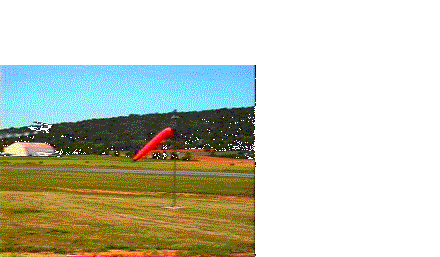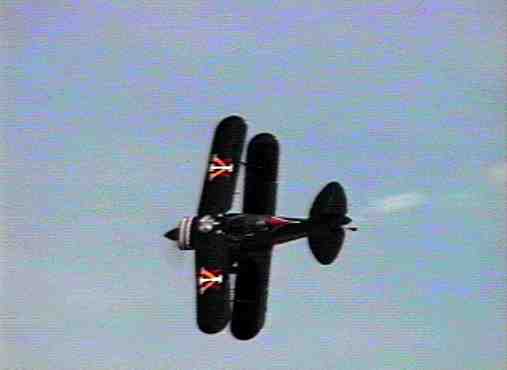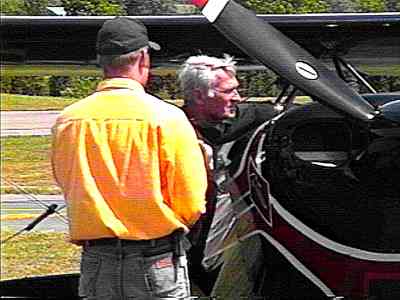Lesson 107
7May 1999
.5 hour
Acro Lesson 12
I Try Hammerheads
--and go to an airshow
Finally the weather cooperated and we got in a full lesson. John
had me begin with a loop. That went pretty well, so we went right
to hammerheads--one, two, three, four.. and somewhere around five or six
I lost track, but there were a lot of them. Hammerheads are where
you pull up into the start of a loop, but then push forward to straighten
out in a vertical climb. You watch your wingtip and the horizon,
and use the stick and rudders to keep pointing straight up. Just
before the airspeed drops off to zero you give it hard rudder to the side
you're looking at (to turn in that direction) and some opposite aileron
(to counteract the lift of the faster-moving outside wing) and a touch
of forward pressure (to keep the lift and gyroscopic forces from flipping
you inverted) and if everything is just right you pivot around the wingtip.
Then you look ahead again, and just before the nose is pointing straight
down you give it some outside rudder to stop the yaw. Build up flying
speed still pointing straight down, then pull up, and you should be at
the entry altitude, but heading in exactly the opposite direction.
So there's no doubt about whether your screwed it up.
(Gyroscopic force is a fairly big player in this maneuver--although
I haven't really been able to isolate it from everything else yet.
You've got that prop and the crankshaft turning maybe 2500 rpm clockwise
(from your point of view)--acting as a huge gyroscope, with almost no aerodynamic
force to counter it. Then you turn its axis of rotation 180 degrees
in something like 2 seconds. You can get a rough idea of what that
does by taking the front wheel off of a bicycle. Hold the axle and
spin the tire as fast as you can (maybe a few hundred rpm?). Then
turn the axle sharply 90 degrees, or so, and see what happens. The
force is proportional to the mass, its distance from the axis, and the
rotation rate--and there's a lot more mass in a crankshaft and propellor
than in a bicycle wheel.)
After that it was a couple of aileron rolls. They're somewhat
easier than slow rolls, and you stay in positive g all the time, but for
some reason or other John skipped them when I began these lessons and just
put me right into slow rolls.
I'm writing this eight days after that lesson and can't remember much
more about the details of it--just that there were a whole lot of hammerheads,
and that after a while I was beginning to get the hang of them. All
in all, the lesson went nicely--in my view of it, anyway.
Certainly far from perfection, but better than before. I was feeling the
airplane pretty well that day, not overcontrolling much at all. Greenwood
said later that he can tell in the climbout after takeoff whether a student
is going to fly well that day. If it's smooth and he doesn't get
pushed over to one side (i.e., the ball stays centered), it's going to
be a good lesson.
Today--15 May--I was able to watch Greenwood do his show routine.
There was a nice homey little airshow at Orange County Airport, and he
performed at the beginning of it (because he had another show this afternoon,
at Burlington, NC). Carol and I drove to Orange and watched the whole
show.

Here's Greenwood taking off. The Pitts is at the left edge of
the first frame. The orange thing in the first few frames is a windsock,
and you can see the puffs of smoke trailing behind the Pitts. The
5 gallon smoke-oil tank sits right between the knees of anyone in the front
cockpit. Maybe you can make out from these few frames, captured from an
8mm camcorder tape, that he did a snap roll immediately after leaving the
ground. In the sixth frame he has gone three-quarters of the way
around and we're looking at the bottom of the lower wing. I haven't
gotten to snap rolls yet, myself, but my textbook says that you haul back
on the stick to stall the airplane very quickly and hit the rudder hard
so that it begins spinning. So in other words, a snap roll is a spin
in the original direction of travel. Here, you can see the Pitts
point up at about 45 degrees to begin the snap roll. That also gets
it moving upward, which is important because it decelerates radically,
and you can see how low it gets by the end of the maneuver. Greenwood
began by leveling off, probably low enough to be in ground effect, even
for those short wings, and accelerating to--I'm just guessing--maybe 100
mph, or so before beginning the snap roll. Even with 200 hp, he's
probably doing only 60 or 70 at the end of it. The Pitts stalls straight-and-level
at--58, is it? (I'll ask him about those speeds.)
He climbed to maybe 1000 feet, did a hammerhead, and passed back over
the runway, doing a four-point roll as he came by. Here you can see
the VMI logos on the top wing. (He told me once that he was 16 when
he was a freshman there.)

Then it was loops, inside and outside, vertical rolls into and out of
hammerheads, inverted turns, rolling turns, 16-point rolls, snap rolls,
cuban-eights, immelmans--just about every maneuver you can think of--for
nearly 15 minutes.
After landing, he gassed up for the flight to Burlington.

He always does the fueling himself, using a length of vinyl tubing that
he keeps in the compartment behind the rear cockpit, because there isn't
room for a standard fuel nozzle between the cowl and the top wing.
It was quite a show--especially for me, watching those maneuvers done
half a mile lower than I try to do them.
I'd guess that the average age of the airshow attendees today was about
40. There were some kids and young moms and dads. But most
of the men had grey hair.
Back to "Learning
Flying"
My
home page.


